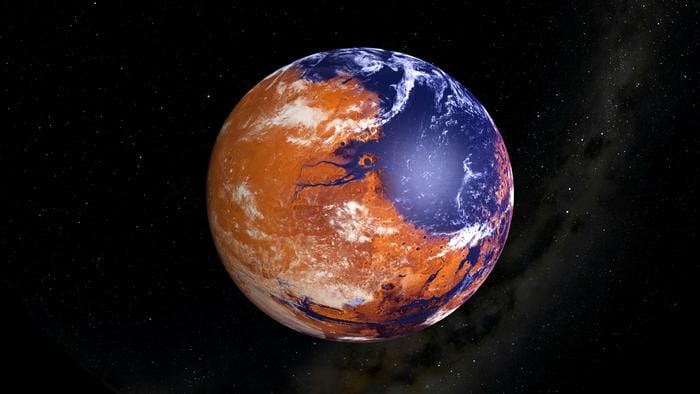Welcome back to the Abstract!
As snow begins to fall and chilly weather becomes the norm, let’s mentally sink into the hot baths that existed on the surface of ancient Mars. Scientists presented unprecedented evidence of these Martian hydrothermal systems inside an ancient crystal found in the Sahara. Of course, all ancient crystals from the Sahara are special, but it turns out this extraterrestrial one is particularly full of wisdom.
Then, indulge in the world's thinnest pasta, and discover the ultimate algae dream home, complete with fiber optic cables. Last, an update from the cosmic jellyfish beat.
Ancient Mars Was in Hot Water, and That’s Good News for Life
In 2011, nomads traveling across the Sahara Desert came across an entrancing black rock from outer space. As it exchanged hands through dealers and found its way into laboratories, the rock was identified as one of the oldest chunks of Mars ever to end up on Earth. The meteorite, nicknamed “Black Beauty,” is about 4.45 billion years old, dating back to a time when Mars was a newborn world (Gender reveal: Red).
Now, scientists have discovered an unprecedented glimpse of early Mars in a zircon crystal from this fascinating space rock. Geochemical analysis of the zircon grain revealed the textural and mineral signatures of thermal water systems that existed on the planet when this meteorite formed the earliest epoch in Martian history, known as the Pre-Noachian period.
In other words, this grain preserves the oldest direct evidence of hot water on Mars. As such, it reveals important insights about the habitability of rocky planets, both because water is an essential for life as we know it on Earth, and because hydrothermal systems can shape magnetic fields. Mars had a stronger magnetic field in the past, but it collapsed some 3.9 billion years ago, a shift that played a role in its transition into the parched and irradiated world we see today.
“Hydrothermal systems are considered critical for the development of life, and so understanding the origin, distribution, and duration of such environments in the geological record of Mars is of primary interest,” said researchers led by Jack Gillespie of the University of Lausanne.
“Hydrothermal systems have also been implicated in the generation of strong remnant magnetization of the martian crust, which preserves a record of the existence of a geodynamo in the early part of martian history,” the team continued. “A better understanding of the timing of hydrothermal activity is critical, therefore, not only for a better understanding of surface hydrology but also for the deep structure of Mars.”
The team examined the microscale zircon crystal with a host of techniques, including scanning electron microscopy, time-of-flight–secondary ion mass spectrometry, transmission electron microscopy, and atom probe tomography. The results revealed the presence of elements like iron, aluminum, and sodium, as well as an iron oxide called magnetite.
These features are analogous to ancient grains found on Earth known to be shaped by hot water, suggesting that similar hydrothermal systems existed on Mars 4.45 billion years ago. The study also bolsters the hypothesis that Black Beauty, which is officially known as NWA7034, came from the Terra Cimmeria-Sirenum province in the southern highlands of Mars, which “is the most highly magnetic region of the martian crust” and “preserves evidence of extensive hydrothermal alteration.”
“Hydrothermal alteration has long been suggested as a possible cause for the highly magnetic properties of parts of the martian crust, a hypothesis supported by evidence for early (pre-Noachian or Noachian) hydrothermal activity preserved in the unusually water-rich and highly magnetic lithology of NWA7034,” the team concluded.
The World’s Thinnest Pasta Is 200 Times Smaller than Human Hair
Britton, Beatrice et al. “Nanopasta: electrospinning nanofibers of white flour.” Nanoscale Adfancs
Scientists have broken the record for the world’s thinnest pasta with a new “nanopasta” that measures just 372 nanometers, which is 200 times thinner than a strand of human hair.
“By dissolving 17 wheat flour in warm formic acid and cooling, a dope can be created which can be electrospun into porous mats of 372 nm fibers of pasta,” said researchers led by Beatrice Britton of University College London. “The pasta was made by applying an electric charge to a starch solution which is ejected towards a grounded substrate while drying during flight.”
Yum, what kind of sauce would you like on your flight-dried electrospun porous mats? The new nanopasta has genuine applications as a biodegradable nanofiber, but my favorite part is that it is literally about throwing spaghetti at a wall, just in a very high-tech way, as shown in the above figure.
My Dream Home Is a Heart Cockle
Heart cockles, a group of marine molluscs, contain little communities of algae in their shells as part of a symbiotic relationship; the algae get shelter and protection, and the cockles get algae-processed nutrients.
Now, scientists have discovered that cockle shells have a host of mind-boggling adaptations to keep these algae happy, including windows that offer “the first example of fiber optic cable bundles in a living creature.”
“We show that the fibrous prismatic crystals act like parallel bundles of fiber optic cables in the shell windows, not just transmitting light but projecting high-resolution images through the window,” that have “a resolution of >100 lines/mm,” said researchers led by Dakota McCoy of the University of Chicago.
In addition, the windows in the cockle shells can filter out damaging UV light while letting regular sunlight through to the algae. This allows the cockle to keep its shell closed while still providing light to its algae inhabitants. The upshot? Heart cockles are lux and it’s okay to be jealous of the algae that get to live in them.
All Hail the Galactic Jellyfish
Galaxies come in a variety of shapes and sizes, but few are as strange as the “jellyfish galaxies” named for long “tails” of star-forming gas that extend out from the main galactic center like tentacles. The tails are formed when galaxies in clusters encounter patches of diffuse gas that act like a cosmic headwind, but the exact dynamics that shape the stunning features are not well-understood.
To get a better sense of these mysteries, scientists ran models of jellyfish galaxies interacting with the environment inside galaxy clusters. The team found that the circumgalactic medium (CGM), which is the gas that surrounds the exterior of these galaxies, probably plays a bigger role in their formation than the gas that exists between stars in the galaxies, which is called the interstellar medium (ISM).
“We find—contrary to popular opinion—that the majority of the gas in the tail originates in the CGM,” said researchers led by Martin Sparre of the University of Potsdam. “Prior to the central passage of the jellyfish galaxy in the cluster, the CGM is directly transported to the clumpy jellyfish tail that has been shattered into small cloudlets. After the central cluster passage, gas in the tail originates both from the initial ISM and the CGM.”
The study’s findings advance our understanding of the complicated processes that create these cosmic tentacles, but they are mostly an excuse to cleanse our eyes with mesmerizing jellyfish galaxies.
Thanks for reading!

